The H Van
|
1947 - 2007 -
60th Anniversary
CitroŽn
Car Club H Van Rally 2009
A pair of
Vans pictured on London's South Bank
Lemon
Jelli
1955 Plateau brochure
French brochure
Dutch brochure
Danish brochure
1968
French brochure
1969 French brochure
Three vans pictured in
Hampshire UK in 2016 and 2017
H
Van in Sneem, Ireland
H
Van at Winchester Auto Barn
H
Van at Winchester Cathedral
|
|
Studies for the vehicle that would
eventually become the Type H began in 1942
on the instructions of Andrť LefŤbvre. The
design brief was for a commercial vehicle
which would employ the principal mechanical
components of the Traction
. The engine came from the 11 CV while the
gearbox, suspension and the interior were
derived from those fitted to the 15 CV.
Unusually, the H had different wheelbases on
each side. The superbly practical and
aesthetically odd body was designed by
Franchiset.
|
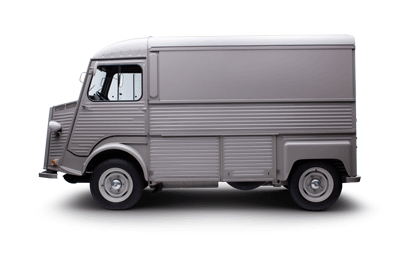 |

Scale model of
the H Van bodywork |
 |
 |
 |
|
In
1949 came the HZ
with a maximum 850kg payload
and with a top speed of 88
kph.
Then
in 1958 the H was superceded
by the HY with a
maximum payload of 1
500kg.
In
1961, the HY DI and
HY DI were launched,
fitted with a four cylinder
Perkins diesel engine of 1
621cm3 capacity developing
42 bhp @ 3 600 rpm and rated
at 7 CV. The six volt
electrical system was
replaced by a 12 volt one.
At
the end of 1963, the HY-72
and HZ-72 were
launched, fitted with a new
petrol engine of 1 628cm3
capacity developing 45 bhp @
4 200 rpm. The reduction in
capacity was achieved by a
reduction in cylinder bore
to 72mm - hence the model
numbers.
|
|
|
In
1947, the Type H was
launched.
|
|
Engine:
|
4
cylinders in line, wet
liners, bore 78mm, stroke
100mm, cubic capacity 1
911cm3, 11 CV rating, 50 bhp
@ 3 800 rpm
|
|
Transmission:
|
Front
wheel drive via 3 speed
manual gearbox, single dry
plate clutch
|
|
Brakes:
|
Hydraulically
operated drums, handbrake
operates on front
wheels
|
|
Suspension:
|
Torsion
bars, four shock absorbers
on front, two on rear
|
|
Steering:
|
Rack
and pinion
|
|
Dimensions:
|
| Length - |
4,26m |
| Width - |
1,99m |
| Wheelbase |
(left) - 2,53m,
(right) - 2,50m |
| Front track
- |
1,61m |
| Rear track
- |
1,65m |
| Unladen weight
- |
1 400kg |
| Maximum
payload |
1 200kg |
|
|
Maximum
speed:
|
78
kph
|
|
Fuel
consumption:
|
13
litres/100km
|
 |
|
|
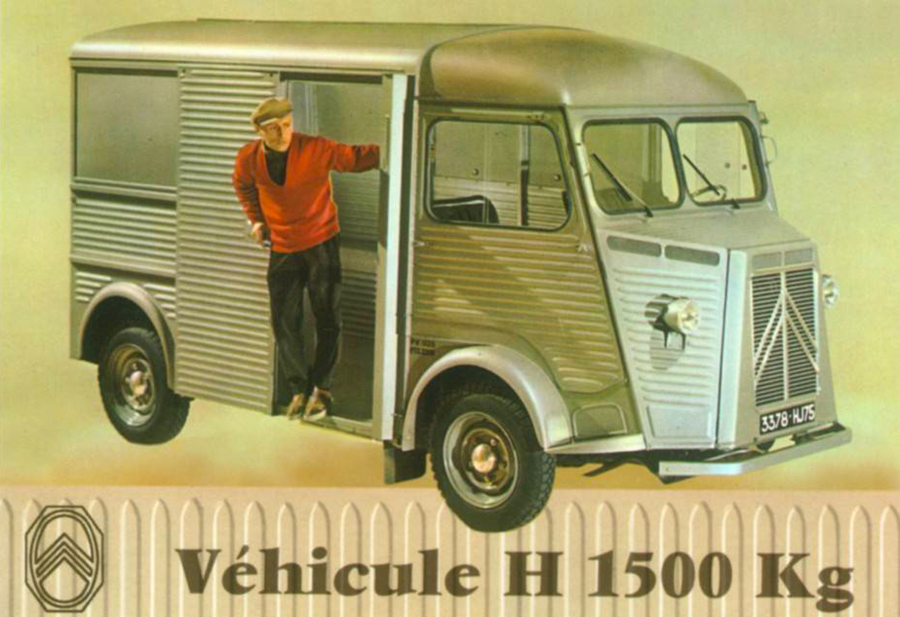 |
|
In 1964, a single windscreen was
fitted to all models. The Perkins diesel was
replaced by an Indťnor engine of 1 816cm3
capacity developing 50 bhp @ 4 000 rpm.
These models were called HY-IN and HZ-IN.
In 1966, the HY 78 and HZ
78 were launched, fitted with the 1
911cm3 engine developing 58bhp @ 4 500 rpm.
The maximum payload of the HZ 72 IN
and HZ 78 IN was increased to 1
000kg thanks to the Indťnor engine being
increased in capacity to 1 946cm3 developing
57 bhp @ 4 000 rpm.
In 1969, a new model, the HX IN2
was launched with a fully laden weight of 3
100kg, increased to 3 200kg in 1969 when it
was called HW IN2. Also in 1969, the
vehicle was given a minor facelift with
rectangular rear wheel arches, new front
indicators, and, less visibly, the fitting
of two instead of four shock absorbers at
the front.
In
1972, the HW was made available with
hydropneumatic suspension at the rear - and
fitted with an ambulance body.
Numerous minor improvements were made
until the end of production in December
1981.
A total of 478 743 models were built
in the factories at Javel and
Aulnay-sous-Bois.
|
|
An
additional 10 016 H Vans were built
in the Netherlands between 1963 and
1970.
|
|
1963
|
100 approx
|
|
1964
|
1450
|
|
1965
|
1600
|
|
1966
|
1732
|
|
1967
|
1680
|
|
1968
|
1347
|
|
1969
|
1630
|
|
1970
|
450 approx.
|
|
|
In the Netherlands H
vans were fitted with front hinged
doors from 1968 below
and right
|
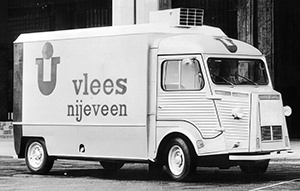 |
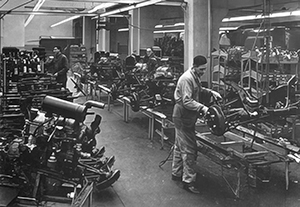 |
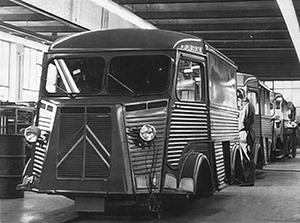 |
|
 |
 |
|
Above,
above
left and left
the production line in the Netherlands
|
|
Below
1968 Dutch advertisement for the HY, 2CV
AZU and 2CV AK
|
|
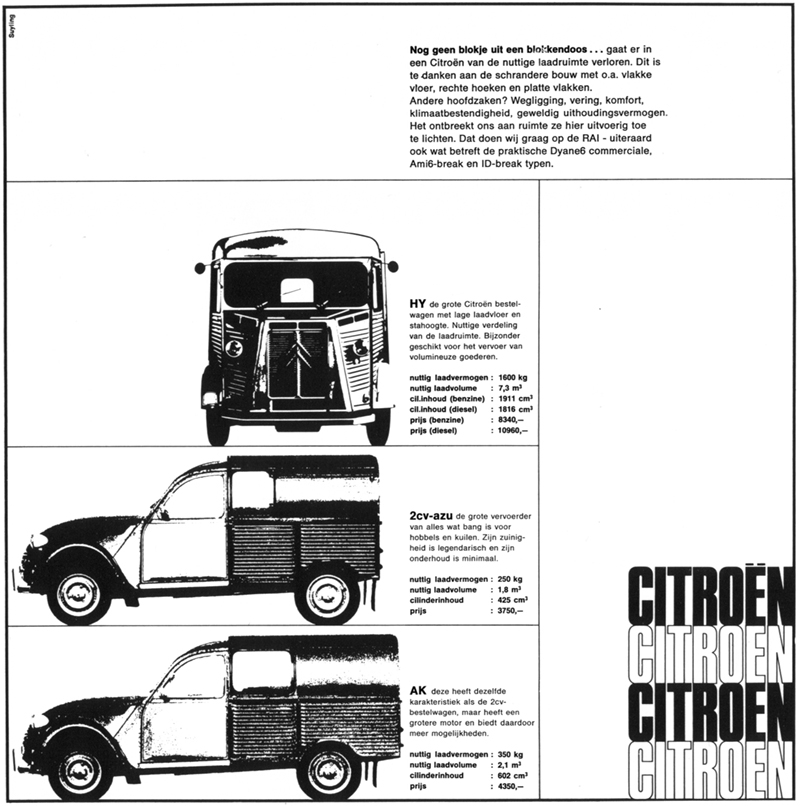 |
|
 |
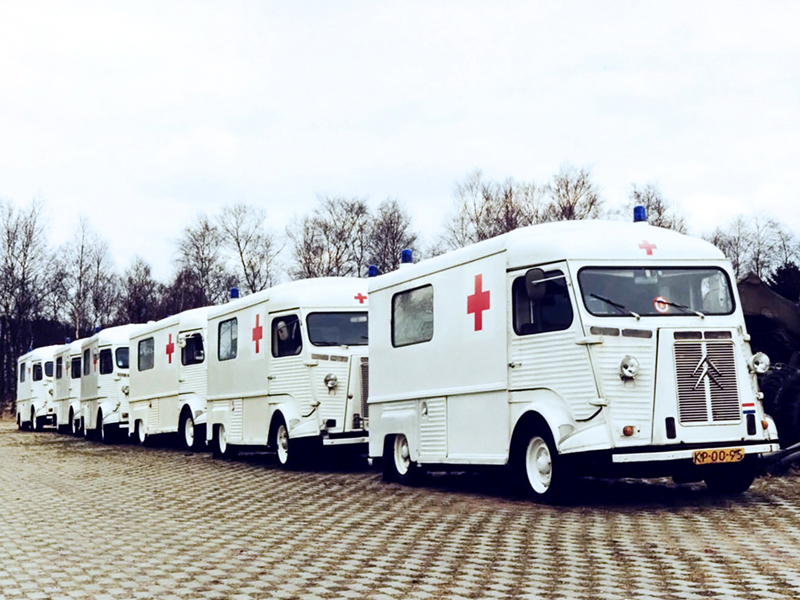 |
 |
|
Above and
below Heuliez conversions
|
 |
 |

|
|
|